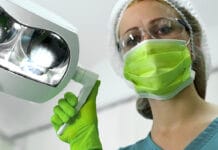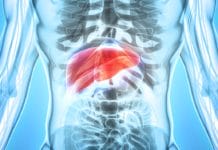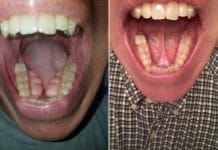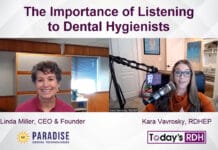Dental hygiene is consistently among the top professions at risk for musculoskeletal disorders (MSD) that affect the soft and hard tissues of the body. A one-year prevalence rate of MSD in dental hygienists ranged from 60% to 96% who are experiencing some form of neck, shoulder, wrist, hand, or back pain. These injuries occur from the precise, repetitive movements and uncomfortable, static positions of everyday practice.6 Musculoskeletal disorders often cause hygienists to reduce hours or to leave the profession completely.9
Burnout is another common problem for dental hygienists and other “helping professions.” The term indicates prolonged exposure to physical and psychological stress, resulting in the deterioration of a person’s emotional functioning and ability to adapt to professional commitments.4 Dental hygienists strive for perfection while battling job demands and time management, usually with few breaks and little to no control over scheduling.6
Dental hygienists can implement certain habits to reduce the risk of musculoskeletal injuries and ensure a more enjoyable career. Complementary and alternative medicine (CAM) therapies may be used to prevent injury and restore your mind and body regularly. CAM therapies have been shown to improve quality of life, reduce work disruptions, and enhance career satisfaction.3
1) Ergonomics
This one is the most obvious, but it also is sometimes the hardest to consistently comply with. Ergonomics is the study of people’s efficiency in their working environment. It is the least expensive preventative measure, a simple self-awareness of posture and positioning. Dental hygienists must assess the best room configuration, loupes and lighting, handpieces, instrument type and grip, operator chair, and the ability to move around a patient.6
Anatomical or “handed” gloves are recommended instead of ambidextrous gloves that may put up to 33% more pressure on the thumbs and fingers. Frequent stretch breaks between patients are highly recommended, and during treatment, the switch from standing to sitting may only shift risk from the lower back to the upper extremities, but alternating positions may be helpful.6,9
Dental hygienists should constantly be looking for any possible ergonomic improvements and organizational interventions that can help reduce the risk of injury.
2) Yoga
Exercise in any form can be a great tool for preventing musculoskeletal disorders and improving mental health. One of the most popular forms of exercise and complementary/alternative medicine therapies is yoga. There are many types of yoga, all physical forms falling under the term Hatha. Some of the more common classes you’ll find are Bikram, Hot, Yin, Vinyasa, Ashtanga, and restorative yoga.
You can practice in a studio, a park, or any place with enough room for a mat. There is a class for everyone, even some that incorporate animals and wine!
Yoga is a top choice because it incorporates mental and physical well-being. Benefits include improved musculoskeletal structure, insulin circuit, hormone system, and metabolism.4 Yoga decreases stress by releasing endorphins and may have a positive effect on the central nervous system to increase pain control and tolerance.
A study of dental professionals who practiced yoga regularly, those who had some other type of physical activity, and those who had none had a 10.5%, 21.7%, and 45.6% incidence of musculoskeletal disorders respectively.7
3) Cryotherapy
Cryotherapy was first used in Japan in the 1970s and has become popular in the United States over the past few decades. It involves exposing the body to extreme cold (-100°C) for short periods of time, typically one to four minutes.2 Chambers may be a full environment-controlled room or a barrel-like structure exposing only the neck down to the cold air and liquid nitrogen. In the full room, clients wear minimal clothing, gloves, wool headband covering ears, a nose and mouth mask, and dry socks and shoes to prevent injury due to exposure.2
Whole-body cryotherapy is widely used in the athletic community due to benefits such as inflammation reduction, analgesia, and enhanced recovery after training. These benefits are comparable to cold-water immersion and ice-pack therapy. Other claims suggest whole body cryotherapy may increase cell rejuvenation, slow signs of aging, and help to treat symptoms of tissue damage while also reducing anxiety and depression.2
4) Chiropractic Care
This therapy focuses on musculoskeletal disorders and the nervous system. It is generally a drug-free approach with the belief that proper alignment, particularly of the spine, enables healing without surgery or medication. Techniques such as the manual diversified technique are used to accomplish high-velocity, low-amplitude thrusting to realign joint subluxations and restore mobility.5 The length of treatment ranges, but chiropractic care can relieve spinal pain and trigger points.
5) Massage
Massage used to be seen as a luxury, but now it has been implemented in many parts of medicine as an important tool in MSD reduction. Massage therapy is the systematic manipulation of the soft tissues of the body, using rhythmical pressure and stroking to prevent, develop, maintain, rehabilitate, or augment physical function or relieve pain.1 Therapists use gliding motions, kneading, penetrating pressure, rapid rate striking, or vibration depending on the type of massage you prefer.
The benefits of massage are short-term, but they help to increase lymph flow, prevent fibrosis, increase the clearance of blood lactate and have positive effects on the immune system. Since massage releases endorphins and serotonin, it also reduces anxiety, depression, and pain.1
6) Acupuncture
Acupuncture is based on the theory that illness is a result of an imbalance in the body’s energy flow called “qi” pronounced “chi.” Qi flows through pathways accessible at approximately 350 points on the body where thin needles are inserted to correct imbalances and restore harmony. It has been used for hundreds of years to help chronic pain, musculoskeletal disorders, and neurological diseases.10
This therapy has physiologic analgesic effects thought to be produced by the release of endogenous opioids and the Gate Control Theory of Pain. There are also psychological effects dependent on patient perception, beliefs, and expectations.10
7) Mindfulness and Meditation
We all know the physical strains of dental hygiene must be addressed, but mental health is an equally important topic. Meditation and mindfulness are now being studied as possible answers to work-related issues to help health-care professionals manage physical and mental stress.4
These practices go hand-in-hand and may have psychological, neurological, and cardiovascular benefits. Concentration meditation is practiced sitting upright and still meant to focus attention on a single object such as breathing. Beginners experience repeated distraction and will learn to recognize but persistently let go of words, worry, plans, daydreams, and discomforts. This helps to develop patience, decrease harsh self-judgment, increases humility, empathy, and the ability to maintain focus.8
Mindfulness is the awareness that comes from paying attention on purpose, being in the present, and being nonjudgmental toward each experience as it unfolds. Research has shown mindfulness improves general health and reduces suffering in those with chronic pain or stress-related disorders.8
Dental hygienists who use CAM therapies as opposed to those who do not show greater overall health (79.3% vs. 54%) and greater overall career satisfaction (59.2% vs. 39%).3 In the future, dental hygiene programs may want to consider adding CAM therapies into class and clinic routines, increasing dental hygiene student awareness on the importance of these practices in our profession. Remember to accommodate your body and mind as much as you strive to accommodate your patients every day!
Now Listen to the Today’s RDH Dental Hygiene Podcast Below:
References
- Bervoets, D.C., Luijsterburg, P.A., Alessie, J.J., Buijs, M.J., & Verhagen, A.P. (2015). Massage therapy has short-term benefits for people with common musculoskeletal disorders compared to no treatment: a systematic review. Journal of Physiotherapy, 61(3), 106–116. doi: 10.1016/j.jphys.2015.05.018.
- Bleakley, C.M., Bieuzen, F., Davison, G.W., Costello, J.T. (2014). Whole-body cryotherapy: empirical evidence and theoretical perspectives. Open access journal of sports medicine, 5, 25–36. doi:10.2147/OAJSM.S41655.
- Chismark, A., Asher, G., Stein, M., Tavoc, T., Curran, A. (2011). Use of complementary and alternative medicine for work-related pain correlates with career satisfaction among dental hygienists. Retrieved from https://www.ncbi.nlm.nih.gov/pubmed/22309868.
- Cocchiara, R.A., Peruzzo, M., Mannocci, A., Ottolenghi, L., Villari, P., Polimeni, A., La Torre, G. (2019). The Use of Yoga to Manage Stress and Burnout in Healthcare Workers: A Systematic Review. Journal of clinical medicine, 8(3), 284. doi:10.3390/jcm8030284.
- Huggins, T., Boras, A.L., Gleberzon, B.J., Popescu, M., Bahry, L.A. (2012). Clinical effectiveness of the activator adjusting instrument in the management of musculoskeletal disorders: a systematic review of the literature. The Journal of the Canadian Chiropractic Association, 56(1), 49–57.
- Johnson, C.R., Kanji, Z. (2016). The impact of occupation-related musculoskeletal disorders on dental hygienists. Canadian Journal of Dental Hygiene. 50. 72-79.
- Koneru, S., Tanikonda, R. (2015). Role of yoga and physical activity in work-related musculoskeletal disorders among dentists. Journal of International Society of Preventive & Community Dentistry, 5(3), 199–204. doi:10.4103/2231-0762.159957.
- Lovas, J.G., Lovas, D.A., Lovas, P.M. (2008). Mindfulness and Professionalism in Dentistry. Journal of Dental Education, 72(9), 998–1009. Retrieved from http://www.jdentaled.org/content/72/9/998.long .
- Morse, T., Bruneau, H., Dussetschleger, J. (2010). Musculoskeletal disorders of the neck and shoulder in the dental professions. Work (Reading, Mass.). 35. 419-29. 10.3233/WOR-2010-0979.
- Yuan, Q.-l. et al. (2016). Acupuncture for musculoskeletal pain: A meta-analysis and meta-regression of sham-controlled randomized clinical trials. Sci. Rep.6, 30675; doi: 10.1038/srep30675.












